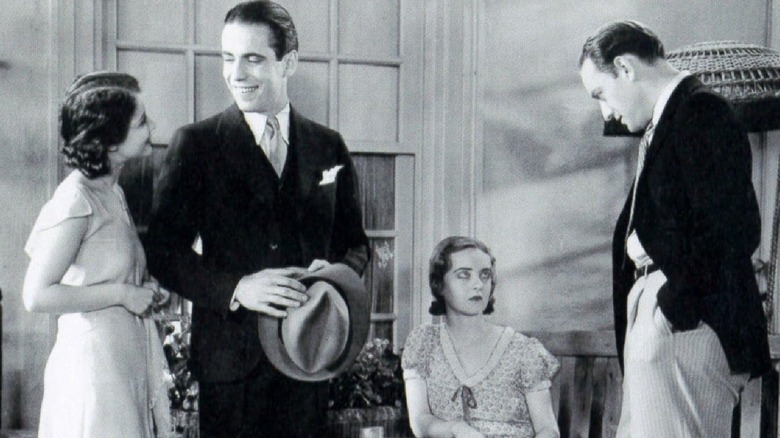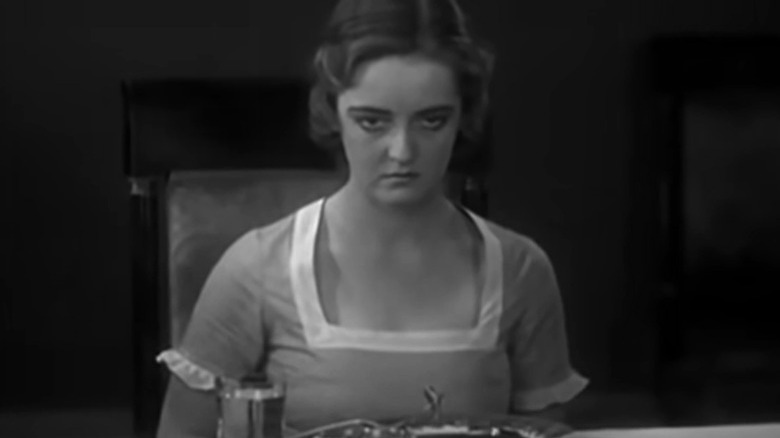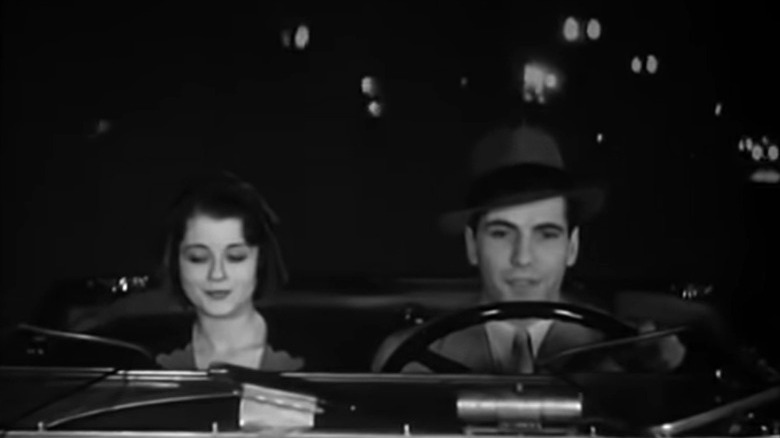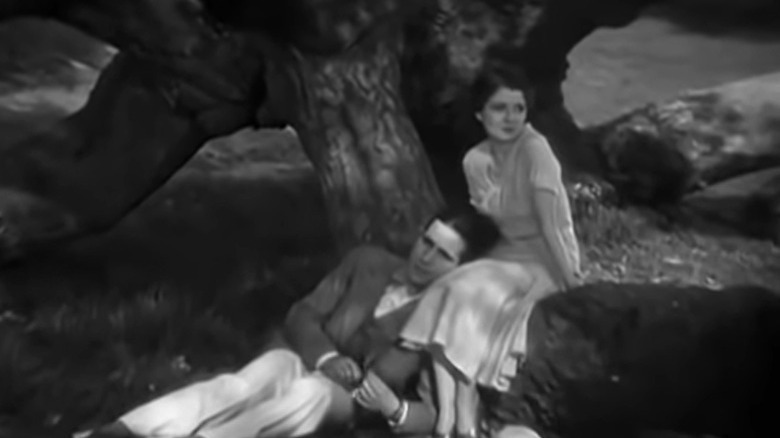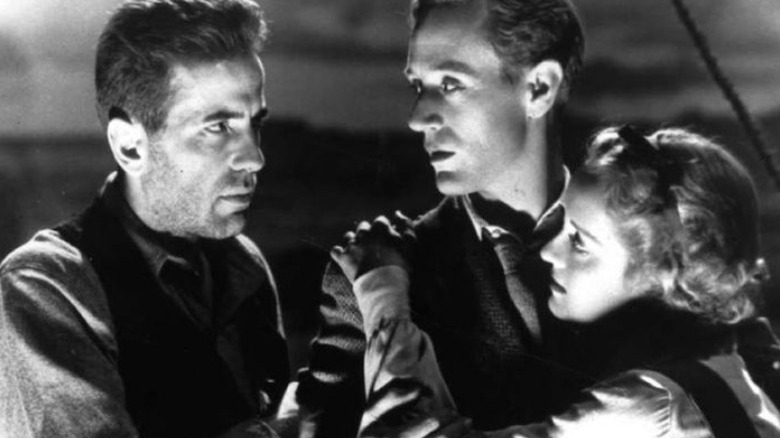Bette Davis' First Film With Humphrey Bogart Was A Low Point For Both
When you think of actors like Bette Davis and Humphrey Bogart, you think of their titanic starring roles that came at the peak of their powers. For Davis, it might well be something like the southern melodrama "Jezebel" or 1950's "All About Eve," the movie that revived her career by letting her embrace her age, her pettiness, and her acid tongue. For Bogart, it would be any of his many roles in film noir, a cinematic movement through the '40s and '50s of which he still registers as the face and the voice.
Digging through their respective careers, one can find early roles that show none of what would make the actors legendary. While technically impressive, these performances lack the vitality, electricity, and movie star charisma that both performers would come to master. And in the early '30s, with the industry in tumult and the Great Depression at its most suffocating, the film production studios weren't necessarily interested in shepherding new talent. If there was a flop, an actor's contract could be nullified.
That was exactly what happened with Davis shortly after the release of her first film, Hobart Henley's 1931 picture "Bad Sister," which was also the first time she and Bogart were in the same film. A dramatic film from Universal based on Booth Tarkington's 1913 novel "The Flirt," it was a fairly standard story of a woman falling for a con man. As Davis recalled in her memoir, "This 'n' That," the movie was "a deadly thing," one that effectively got her fired from Universal and ruined Bogart's film career just as they were starting.
Modesty
Many artists get embarrassed about early work. That's the nature of taking pride in what you do, and having a serious perspective on the quality of your output. Even in the Depression-era days of classic Hollywood, an actor might look back at their first films with a chip on their shoulder. Even then, when actors were effectively considered interchangeable and married to abusive multi-year contracts that would leave them penniless if they dared to object to a role, there would be some self-consciousness, and Bette Davis was no stranger to that.
Davis' illustrious, decades-long career would become one of Hollywood's most legendary, something you can tell from a glance at her 15 best films. Still, her arrival in the industry in the early '30s was fairly low-key, one typical of a girl who traveled across the country for a chance at stardom. Her brief time on Broadway had not exactly prepared her for the world of the movies. As she recalled in a wide-ranging interview with Dick Cavett in 1971, she was "the most modest virgin who ever walked the earth" by the time she showed up in town. Per Whitney Stine's "Mother Goddam," casting directors and producers found her homely. Even William Wyler, the director who would be most influential in developing her performance style, mocked her appearance.
Because of that, the role given to her in "Bad Sister," a film produced by Universal's Carl Laemmle, Jr., plays off of what the industry expected of her. By the time Davis became a known quantity, she probably could have played the flirtatious, reckless titular bad sister. Instead, she's left with the thankless role of the kind sister.
A deadly thing
Whether or not "Bad Sister" was the "deadly thing" that Bette Davis remembered, it's still no masterpiece, coming in at a little over an hour and possessing a strict moral framework by which it judges its lead character. These days, the most interesting thing about the movie is that it stars both Davis and Humphrey Bogart early on, and both of them are practically unrecognizable. Considering how significant their shared casting would be, it's funny that they never even share a frame.
The movie tells the story of the Madison's, a seemingly well-off family in a small Ohio town. While the family works hard in the house, the bad sister Marianne (Sidney Fox) sleeps in, spending most of her time attending to her numerous suitors, men like the doctor Dick (Conrad Nagel). Meanwhile, Laura (Davis) longs for him.
Laura ends up being one of the more fascinating characters in the movie. While she never quite drives the drama and definitely ends up playing second fiddle to Marianne, it's in her reserved silence that Davis builds the character. Cast in shadow next to Sidney Fox's beauty light, Davis does a wonderful job playing the good girl who will "never marry" due to feeling undesirable. Even when she plays piano for one of her sister's suitors, all the man can talk about is Marianne.
When smooth-talking con man Val (Bogart) first arrives, some twenty minutes into the picture, he quickly brings his car up to the curb, tilting his hat to make an impression on Marianne. Filming love scenes may never have been Bogart's forte, but scenes like this show off his devilish grin and charisma.
Young Bogart
In a way, the role of Val in "Bad Sister" was setting a precedent for the kinds of slick gangster roles Humphrey Bogart would take on throughout much of the '30s. But his voice is thinner, he's uncomfortably fresh-faced, and he lacks the presence so familiar to fans of "Casablanca." If anything, he's of a piece with much of the movie's relative blandness, bringing a bit of life but not quite selling the bad boy routine.
His relative lack of presence is just one reason the movie didn't do well. But Bette Davis, per Whitney Stine's "Mother Goddam," thought she was bad too and cried over her career ending on her way home from the premiere.
Like Bette Davis, Bogart came up through Broadway and New York theater before going to Hollywood in 1930, where he found mostly small roles waiting for him. Per A.M. Sperber and Eric Lax's "Bogart," the early days of sound cinema required extensive diction lessons for the actors who had come up in sound film. Bogart's theater experience meant his early directors would ask him to assist the lead actors, much to their chagrin. But that didn't mean he got top billing.
In her memoir "This 'n' That," Davis recalled Bogart being fired from Universal like she was after the failure of "Bad Sister" (as well as two other Universal movies she did later in 1931). But Bogart was actually under contract to Fox, having been loaned out for the production of "Bad Sister." For him, the movie was just another small role in a flop. Shortly after, he returned to Broadway.
The rise of Bogart and Davis
Broadway was a significant place for Humphrey Bogart to work, and a welcome reprieve from his treatment in Hollywood. Throughout the early '30s, the cycle would go back and forth as he moved from coast to coast, ultimately working to a point where he would be signed to Warner Bros. and make most of his iconic films. The only reason that fortuitous connection happened was because of Bogart's performance in the Broadway production of "The Petrified Forest," the play that ultimately saved Bogart's career. His performance as Duke Mantee in the show was thoroughly translated to the film version, where he terrorized two young lovers in a convenience store, played by Leslie Howard and... Bette Davis, who survived her contract with Universal ending.
She learned from the failure of "Bad Sister," willing to pursue more exciting and challenging roles. Movies like "Dangerous" and "Of Human Bondage" showed a uniquely committed actress, one who could take on any role and make it compelling and memorable.
According to Sperber and Lax's "Bogart," the two ended up being in six movies together, with the final being the 1937 melodrama "Dark Victory." Toiling in near-anonymity for years, underestimated by the studio heads, both Davis and Bogart gradually honed their performance style. By the end of the '30s, they each had a number of unforgettable performances under their belt, although Bogart had yet to really lead a movie in the way Davis had. But Bogart's major film breakthrough having him play a gangster villain to the rising Davis had some poetry behind it. By "Dark Victory," they had both firmly established their place in Hollywood.
